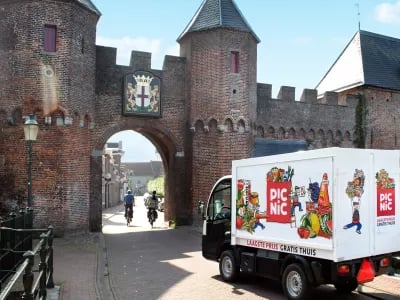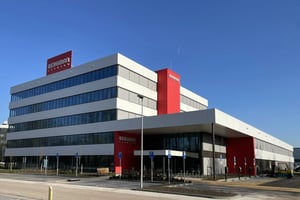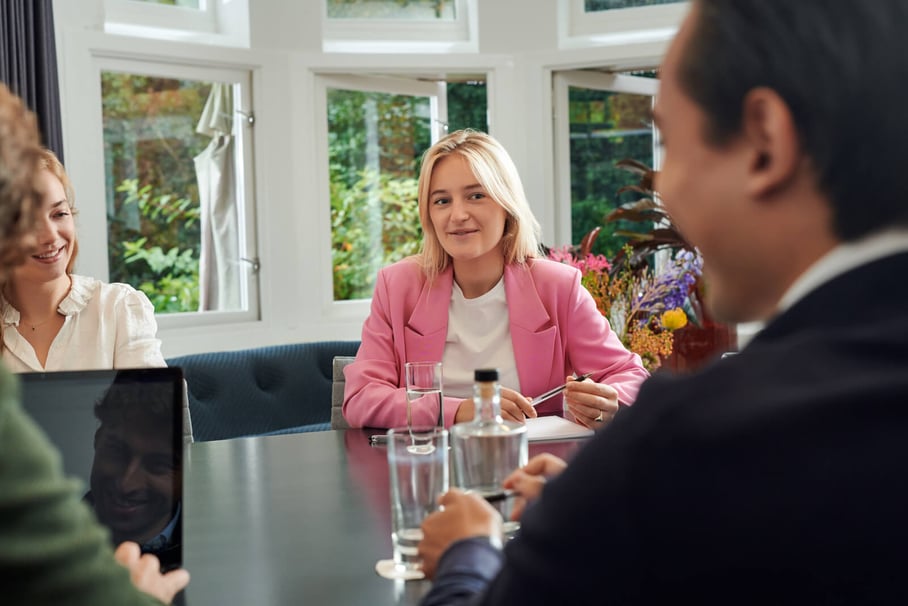This past spring, consumers in New York and Paris gained the option of having their day-to-day groceries – things like ice cream, soft drinks and shampoo – delivered to their door in reusable packaging. That was when Loop, a new ‘zero waste’ platform founded by a coalition of big multinationals, started a pilot in those two cities. Is this the future of grocery shopping?
With a quote of Michiel Muller, co-founder of online supermarket Picnic, an NPM Capital portfolio company.
It takes a moment to adjust to seeing a one-litre pack of Häagen-Dazs presented in an elegant, stainless steel container. Once all the ice cream has been eaten, the packaging won’t go into the bin, but rather into a ‘personal reusable container’. That container will then be collected when the next order is delivered, after which the ice cream container will go to Loop’s cleaning and sterilisation centre to be cleaned and returned to the Nestlé factory. Once there, the container will once more be filled with ice cream for another consumer.
The idea for Loop arose out of the personal frustration of Tom Szaky, CEO and co-founder of TerraCycle, a company that specialises in recycling hard-to-recycle materials. TerraCycle is one of the few companies that has found a way to process plastic from the ocean into food-grade plastic that can then be sold to large-scale producers. “The problem is that so much plastic is ending up in the oceans now that it can’t be recycled,” Szaky says. “Of course recycling is crucial, but it won’t solve the real problem, which is the ever increasing amount of waste plastic. That led to Loop: we don’t see plastic itself as the problem, but rather the fact that the plastic is only made for one-time use.”
Too much effort
TerraCycle has spent more than a year developing the new platform, together with businesses such as Procter & Gamble, Nestlé, PepsiCo, Unilever and more than a dozen other enterprises. The idea was that every item of packaging should be reusable more than 100 times. Consumers can simply order their favourite brand online through Loop – the only difference is in the packaging. Logistics partner UPS delivers the groceries right to consumers’ homes and takes away the packaging from the previous order, all in the same visit.
Szaky sees two possible problem-solving strategies: either convince consumers to change their behaviour, or assume people are going to behave in a certain way and adjust the system so the problem is resolved during the process. “It is phenomenally difficult to get consumers to change,” Szaky says. “The first question we asked ourselves when we set up Loop was: what is so appealing about disposability? What has made that model in particular so dominant? The answer to those questions is: it’s easy and it’s cheap.”
This is precisely why so many alternative systems that attempt to tackle waste at the source either never get off the ground at all or experience uncertain success. For many consumers, hauling a bag full of refillable packaging – or even Tupperware – to the ‘packaging-free supermarket’ is just too much effort. As Szaky says, “Solutions that aren’t designed from the consumer’s perspective will never find wide-spread success Loop has. It doesn’t matter to you which bin you throw an empty packet into. You don’t even have to rinse it – something a lot of recycling systems require. And once the customer is in our deposit system for recyclable packaging such as bottles, it doesn’t even cost more than just throwing it away. The return logistics costs are included in the product price.”
Smaller environmental impact
According to UPS, the logistics partner that was selected for the first Loop pilot, the system is a good fit for their existing activities. UPS Global Director of Sustainability Patrick Browne says that parcel vans no longer go out on a round full and return empty at the end of the day. Instead, the system is being used more efficiently because the vehicles are being refilled with return boxes over the course of the day. It’s true that delivering and collecting products at the consumer’s door – not to mention returning the clean packaging to the producers – has a negative impact on the company’s ecological footprint, but TerraCycle’s calculations show that, in terms of the total environmental impact, reusable packaging scores between 50% and 75% better than conventional alternatives. This is possible because the greatest impact of an item of packaging is created during production, through things like raw materials and energy. The environmental impact of collecting and cleaning the packaging is still significantly lower than that of re-manufacturing, Szaky explains.
The fact that the packaging remains the property of the producer also generates new opportunities. After all, whereas disposable packaging can only be categorised as an expense (and therefore something for which you want to pay as little as possible), producers can take advantage of reusable packaging as a key selling point. With that in mind, that stainless steel Häagen-Dazs container is not only much more ‘chic’ – it also keeps ice cream at a low temperature for several hours outside the freezer. And Loop has even sparked product innovations. Because it is proverbially difficult to reuse a tube of toothpaste, Unilever has developed toothpaste in tablet form, so consumers can now chew their teeth clean instead of getting paste out of a tube. It goes without saying that those tablets are supplied in reusable packaging.
Although the Loop platform is very similar to the milkman’s deliveries in the early 20th century, the method has not yet shown to be viable in practice. The pilots have yet to confirm, for instance, whether the return containers can stand long-term intensive use, what problems are likely to arise through filling separate batches in the various factories, or the extent to which consumers are actually prepared to embrace the novel packaging as the new normal. As Szaky says, “Its success will depend on whether the consumer accepts it; of course, the fact that we sell some extremely successful established brands will help. We don’t have to bring any new brands to market – we’re just offering an alternative way to get those same brands.”
Waste crisis
The fact that eight out of the ten producers Greenpeace has identified as contributing the most to the ‘plastic soup’ are now part of Loop is a clear sign of a nascent change in the mindset within those producers. “Objectively speaking, we’re up to our ears in a waste crisis, and more and more brands are genuinely looking for solutions that can put an end to that crisis,” Szaky says.
Michiel Muller, co-founder of online supermarket Picnic:
“It’s perfectly possible that this kind of return system could become dominant. In fact, we have already been part of a Unilever pilot using refillable detergent packaging. And the Solero ice cream brand is working with us to sell ice creams that are free from plastic packaging. The fact is that the current packaging and distribution process involves a lot of waste, much of which comes from the traditional supermarket model with physical shops. Products are being packaged for shops with an eye to shelf-space and presentation, rather than making them as efficient as possible. Take pots of baby food, for instance: they come in packs of six, on a piece of cardboard, with a plastic sleeve around them. That’s great for the shop, because they can fit precisely six pots in the same flavour in a row on the shelf. From our perspective, it would be much better to have a tray or a crate of a hundred pots; that would save a lot of packaging material too. Another well-known example is cornflakes, which are packed as standard in big cardboard boxes that are only half full. A big box like that catches the eye and looks good in the shop, but at the same time lorries full of cornflakes are driving around that are actually half full of air – never mind all the unnecessary cardboard.”
“We’re already making strides in redesigning the supply chain. We worked with Heineken to develop the KwartKrat, a cardboard holder that contains six returnable bottles of Pilsener. We leave the heavy plastic beer crates behind at our city hub. That shows the crucial importance of cooperation if you want to change things and reduce packaging material. But there’s a lot you can do yourself: we deliver our products in bioplastic bags, and when we come with another delivery we pick them up and send them for recycling.”
“It’s true that innovation has little chance of success if the consumer has to pay more for it or make more of an effort. A lot of people will say that sustainability is very important to them, but if it has too many negative consequences they don’t stick with it. The magic is in coming up with something that makes it both easier and more sustainable. Our pilot, where our runners (deliverers) pick up library books and webshop returns parcels, is a good example of that. People like having that kind of thing done for them, and they seem to embrace a service like that straight away because we also drive 100% electric cars. And then we collect the packages centrally in our city hub, so only one delivery van has to go out to pick up a hundred parcels, instead of making a hundred different runs into the city. This kind of initiative stands or falls on the quality of your software and technology. Our runners each have a device that lets them input and register things really easily and lets us know exactly what’s going on while they’re on their route. You need that to keep track of the distribution and returns process.”
Also read: ‘More revenue growth for Dutch e-commerce market in 2018’













